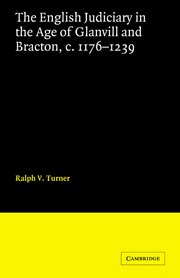Book contents
- Frontmatter
- Contents
- Acknowledgements
- Abbreviations
- 1 THE REPUTATION OF THE ROYAL JUSTICES
- 2 GLANVILL AND HIS COLLEAGUES, c. 1176–89
- 3 THE ORIGINS OF A PROFESSIONAL JUDICIARY IN THE REIGN OF RICHARD I
- 4 KING JOHN'S CORPS OF JUSTICES
- 5 PATTISHALL, RALEIGH AND THEIR COLLEAGUES
- 6 THE WORK OF THE JUSTICES
- Conclusion: The judges and their critics
- Appendix: Royal justices, c. 1176–1239
- Manuscript sources
- Index
- CAMBRIDGE STUDIES IN ENGLISH LEGAL HISTORY
1 - THE REPUTATION OF THE ROYAL JUSTICES
Published online by Cambridge University Press: 07 October 2011
- Frontmatter
- Contents
- Acknowledgements
- Abbreviations
- 1 THE REPUTATION OF THE ROYAL JUSTICES
- 2 GLANVILL AND HIS COLLEAGUES, c. 1176–89
- 3 THE ORIGINS OF A PROFESSIONAL JUDICIARY IN THE REIGN OF RICHARD I
- 4 KING JOHN'S CORPS OF JUSTICES
- 5 PATTISHALL, RALEIGH AND THEIR COLLEAGUES
- 6 THE WORK OF THE JUSTICES
- Conclusion: The judges and their critics
- Appendix: Royal justices, c. 1176–1239
- Manuscript sources
- Index
- CAMBRIDGE STUDIES IN ENGLISH LEGAL HISTORY
Summary
A monk in the mid twelfth century took note of the progress of his day; among the advances he observed was the growth of ‘so many kinds of professions … varieties of positions and posts’. Certainly the appearance of professional civil servants was a noteworthy change in the later twelfth and early thirteenth centuries. A significant group of English civil servants are the royal justices in those crucial years for the growth of the common law, the time between the writing of the two great legal treatises: Glanvill, written c. 1187–9, and Bracton, once thought to have been written in the late 1250s, but now known to date in its earliest version from the 1220s and 1230s. Those years saw the appearance of professional judges in England's royal courts.
Great barons, bishops and abbots served Henry II, his sons Richard I and John, and his grandson Henry III as judges from time to time, particularly as itinerant justices in their own counties. Others who might be termed the king's ‘men-of-all-work’, serving him in the chancery, at the Exchequer, or as sheriffs also sat occasionally on the bench. By the last ten years of Henry II, however, we can make out some royal servants who were beginning to concentrate on the work of justice and who must be regarded as forerunners of a professional judiciary.
- Type
- Chapter
- Information
- Publisher: Cambridge University PressPrint publication year: 1985



